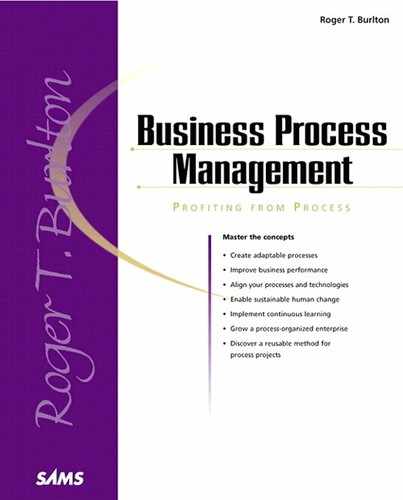Architecting Processes and Aligning Business Strategies
The purpose of the Architect and Align phase is to identify the relationships among business processes, technologies, facilities, human resources, and business strategy. An organization maps this information to the results of the Business Context phase to produce priorities for a program of change. The processes are defined based on stakeholder service and interaction lines. The program of change is aligned to the business strategy and to all architectural components.
Results
The major consolidated deliverable from the Architect and Align phase, a Business Architecture Report, summarizes the phase results. It starts with the definition of a common set of business processes and ends with a program of change that prioritizes the processes and other architectures. A key component will be the process migration strategy, a ranked list complete with the rationale of the processes that seem to hold greatest potential for enabling change in business performance, as well as a description of the potential ramifications. The process architecture also links to the overall architectures of other organizational assets.
The net result is a migration strategy organized by process, which shows the alignment of recommended changes to organization, technology, facility, and human architectures. These process changes will deliver the greatest degree of business performance improvements.
Concepts Handled
Figure 5.6 depicts the concepts dealt with in the Architect and Align phase.
Concept Knowledge Reused
The knowledge gained and associated with the many concepts just discovered in the Business Context phase will be reused in conducting architectural analysis. The business stakeholder relationship criteria are especially important.
From each business stakeholder group, you can identify the events and outcomes and, therefore, the processes for the process architecture. From the criteria, principles, expectations, key performance indicator targets, and critical success factors for each, you can prioritize which processes should be dealt with first. Understanding these is required to create the new knowledge required for architecture and program management.
Concept Knowledge Created
The first set of knowledge to be created in this phase will concern the concepts of enterprise asset architectures. These represent the reusable assets of the organization that provide leverage with their repeated application. Starting with the process architecture creation from the stakeholder interactions and applying the stakeholder criteria, a prioritized list of business areas can be defined. This initial set of focus areas then provides the basis for assessing the fit of knowledge types needed to support them. The processes and knowledge then allow a more focused determination of which technologies have the greatest potential for leveraging business performance improvement potential.
The most appropriate strategy for organizational alignment is determined to make the process, knowledge, and technology solutions most viable. Facility options are also addressed, especially ones that affect the potential relocation of staff to new sites, cities, or countries.
Finally, within asset architecture, the requirements of human resources are examined, and the fit with current capacities as well as skills and competencies is investigated. The architecture alignment is iterated until all components fall in sync with one another, and a set of architectures with integrity is produced. The architectures guide the organization in producing and managing a program of change that rolls out the benefits envisioned in the architectures and stakeholder expectations.
An overall strategy can be developed that synchronizes the dependencies among the total set of changes that must be produced. As it is a strategy, it must be adaptable enough to be re-examined regularly to accommodate marketplace variations. By examining the high-level costs, benefits, and risks in a business case, the overall program can be justified, funded, and provided resources.
Specific projects will be initiated and rolled out within a shorter planning horizon. Each process-oriented project goes through the subsequent Process Management Framework phases, starting with the Vision phase. Others might deal with only infrastructure and can proceed directly to the Develop phase.
The net result of the Architect and Align phase is a changeable, manageable program, based on business stakeholder needs and a process organization. Program components are fully traceable to business drivers, and decisions regarding resourcing can be made.
Steps
The following steps are recommended to populate the concepts of the Architect and Align phase. They are described in detail in Chapter 11, “Configuring Business Processes and Aligning Other Strategies”:
1. | Identify business processes. |
2. | Match processes to criteria and prioritize. |
3. | Identify information and knowledge needs. |
4. | Identify strategic technologies. |
5. | Identify facility requirements. |
6. | Determine organization strategy. |
7. | Determine human capabilities. |
8. | Determine alignment opportunities and constraints. |

